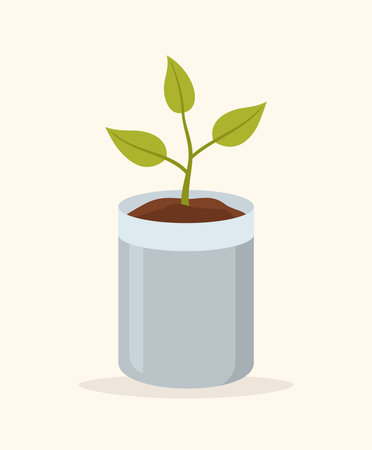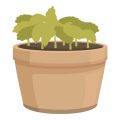1. Soil & Compost
If youre new to gardening, understanding soil and compost is one of the most important first steps. Healthy plants start with healthy soil, and knowing the basics can make all the difference in your garden’s success.
Different Types of Soil
Not all soil is created equal. The type of soil you have affects how well your plants grow. Here are the most common types:
| Soil Type | Texture | Drainage | Best For |
|---|---|---|---|
| Sandy Soil | Gritty, loose | Drains quickly | Root vegetables like carrots and potatoes |
| Clay Soil | Heavy, sticky when wet | Poor drainage | Perennials and shrubs once amended |
| Silty Soil | Smooth, soft | Retains moisture well | Most vegetables and flowers |
| Loamy Soil | Balanced texture | Good drainage and moisture retention | Ideal for most garden plants |
The Importance of Soil Health
Your soil is more than just dirt—its a living ecosystem full of nutrients, microbes, and organic matter. Healthy soil provides essential nutrients to plants, helps retain water, and supports strong root systems. You can improve soil health by avoiding over-tilling, adding organic matter, and rotating crops each season.
What Is Compost and Why It Matters
Compost is decomposed organic material made from things like food scraps, grass clippings, and leaves. Adding compost to your soil boosts its fertility by enriching it with nutrients and improving its structure. It also encourages beneficial microorganisms that help plants absorb what they need to thrive.
Benefits of Using Compost in Your Garden:
- Improves soil texture for better root growth
- Adds essential nutrients naturally
- Helps retain moisture in the soil
- Reduces the need for chemical fertilizers
- Cuts down on waste by recycling kitchen and yard scraps
Pro Tip:
If youre just starting out, you don’t need a fancy compost bin. A simple pile in a corner of your yard or a small container under your sink can be a great way to begin making your own compost at home.
2. Plant Types & Seasons
When starting your gardening journey, one of the first things to learn is the difference between plant types and how they relate to seasons. Understanding these terms helps you plan your garden more effectively and avoid common mistakes.
Annuals, Perennials, and Biennials
Plants are often categorized by how long they live and bloom. Heres a quick breakdown:
| Type | Description | Example Plants |
|---|---|---|
| Annuals | Complete their life cycle in one growing season. They sprout, flower, produce seeds, and die all in the same year. | Marigolds, Petunias, Zinnias |
| Perennials | Live for more than two years. They may die back in winter but return each spring from the same root system. | Daylilies, Coneflowers, Hostas |
| Biennials | Take two years to complete their life cycle. In the first year, they grow leaves; in the second year, they flower and set seed. | Foxgloves, Parsley, Hollyhocks |
Why Knowing Your USDA Hardiness Zone Matters
The USDA Plant Hardiness Zone Map divides North America into zones based on average annual minimum temperatures. This helps gardeners figure out which plants are most likely to thrive in their area.
You can find your zone by entering your ZIP code on the USDA website. Zones range from 1 (coldest) to 13 (warmest). Knowing your zone will help you choose plants that can survive winter in your region.
Example:
If you live in Zone 5, a plant labeled “Hardy to Zone 7” may not survive your winter unless you bring it indoors or treat it as an annual.
Quick Tip:
Always check plant tags or seed packets—they usually list the appropriate hardiness zone and whether the plant is an annual or perennial in your area.

3. Sunlight & Watering
Understanding how much sunlight your plants need and how to water them properly is essential for any beginner gardener. Let’s break down some of the most common terms and tips you’ll come across when it comes to light and water requirements.
Sunlight Terms You Should Know
Different plants have different needs when it comes to sunlight. Here’s a quick guide:
| Term | Description |
|---|---|
| Full Sun | At least 6–8 hours of direct sunlight per day. Great for most vegetables and flowering plants. |
| Partial Sun / Partial Shade | 3–6 hours of sun each day, often in the morning or late afternoon. Good for herbs and some leafy greens. |
| Full Shade | Less than 3 hours of direct sunlight per day. Works for ferns, hostas, and other shade-loving plants. |
Drought-Tolerant Plants
You might also hear about “drought-tolerant” or “low-water” plants. These are plants that can survive with minimal watering once established. Theyre perfect if you live in a dry climate or want a low-maintenance garden. Popular choices include lavender, succulents, yarrow, and Russian sage.
Watering Basics for New Gardeners
Proper watering isnt just about frequency—it’s also about technique. Here are a few simple tips:
- Water deeply, not just often: Deep watering encourages strong root growth. It’s better to water thoroughly less often than to sprinkle a little every day.
- Morning is best: Watering early in the day allows leaves to dry off before evening, reducing the risk of mold or mildew.
- Avoid overhead watering: Use a soaker hose or water at the base of the plant to keep foliage dry and prevent disease.
- Check soil moisture: Stick your finger into the soil up to your second knuckle—if it feels dry, it’s time to water.
Quick Tip:
If you’re unsure how much water your plant needs, look it up by name. Most plant tags or online guides will tell you whether it prefers moist soil or likes to dry out between waterings.
4. Pruning & Deadheading
Understanding how and when to prune or deadhead your plants is key to keeping your garden healthy and looking its best. These terms might sound a little intimidating at first, but they’re simple gardening techniques that every beginner should know.
What is Pruning?
Pruning means cutting away parts of a plant — such as branches, stems, or leaves — to improve its shape, remove dead or diseased areas, or encourage new growth. It’s like giving your plant a haircut to help it grow better and stay healthy.
Common Reasons for Pruning:
- Shape the plant: Keeps the plant looking tidy and well-formed.
- Remove damaged parts: Prevents disease from spreading.
- Encourage growth: Stimulates new branches and flowers.
What is Deadheading?
Deadheading is the process of removing spent (dead) flowers from a plant. This helps direct the plant’s energy into producing more blooms instead of making seeds. It also keeps your garden looking neat and colorful for longer.
Benefits of Deadheading:
- Promotes more flowers: Many plants will keep blooming if old flowers are removed regularly.
- Keeps plants tidy: Removes wilted or brown petals for a cleaner look.
Quick Reference Table
| Term | Definition | Main Purpose |
|---|---|---|
| Pruning | Cutting back parts of a plant | Improves shape, removes damage, encourages growth |
| Deadheading | Removing spent flowers | Encourages more blooms, keeps garden tidy |
Both pruning and deadheading are easy to do once you get the hang of them. Use clean, sharp tools and always check what type of plant youre working with—some need more trimming than others! Learning these two basic maintenance tasks will go a long way in helping your garden flourish.
5. Mulching & Weeding
If youre just starting out in gardening, two words youll hear a lot are mulching and weeding. These simple but powerful practices can make a huge difference in how healthy and low-maintenance your garden is.
What Is Mulch?
Mulch is any material spread over the surface of the soil to cover it. It can be organic like shredded bark, straw, leaves, or grass clippings, or inorganic like gravel or black plastic. Most beginner gardeners use organic mulch because its easy to find and helps improve the soil over time.
Benefits of Mulching
| Benefit | Description |
|---|---|
| Weed Control | Mulch blocks sunlight from reaching weed seeds, stopping them from growing. |
| Moisture Retention | It keeps water from evaporating too quickly, so you dont have to water as often. |
| Soil Temperature Regulation | Helps keep roots cooler in summer and warmer in winter. |
| Soil Improvement | Organic mulch breaks down over time, adding nutrients to the soil. |
How to Apply Mulch
Apply a layer of mulch about 2–3 inches thick around your plants. Be careful not to pile it right up against stems or trunks—leave a little space so plants can breathe and avoid rot.
The Basics of Weeding
Weeds are unwanted plants that compete with your flowers or vegetables for sunlight, water, and nutrients. Regular weeding keeps your garden neat and helps your plants grow better.
Tips for Effective Weeding
- Weed regularly: Try to pull weeds when they’re small—it’s much easier!
- After watering or rain: Damp soil makes it easier to remove the whole root.
- Use tools: A hand fork or hoe can help with stubborn weeds.
A good combo is mulching right after weeding. That way, you block new weeds from sprouting while keeping moisture in the soil where your plants need it most.

